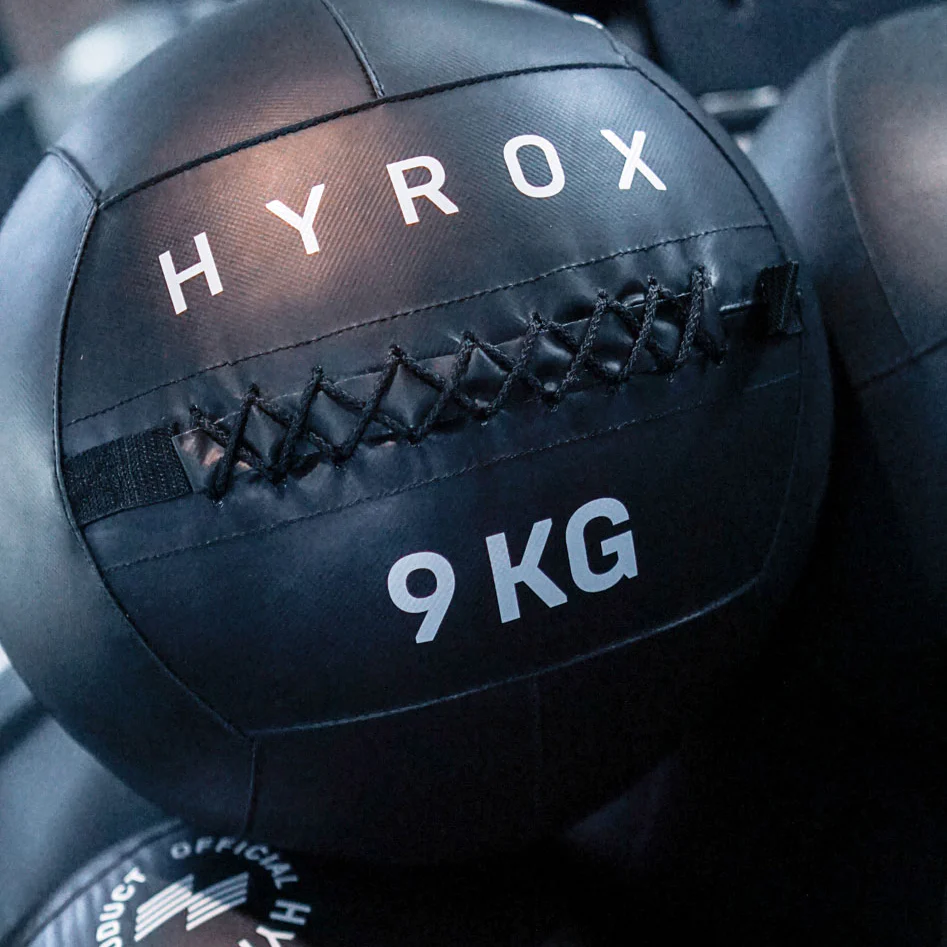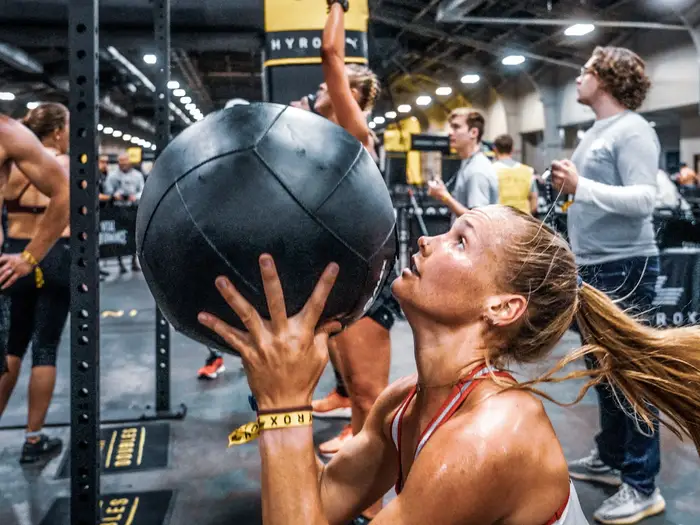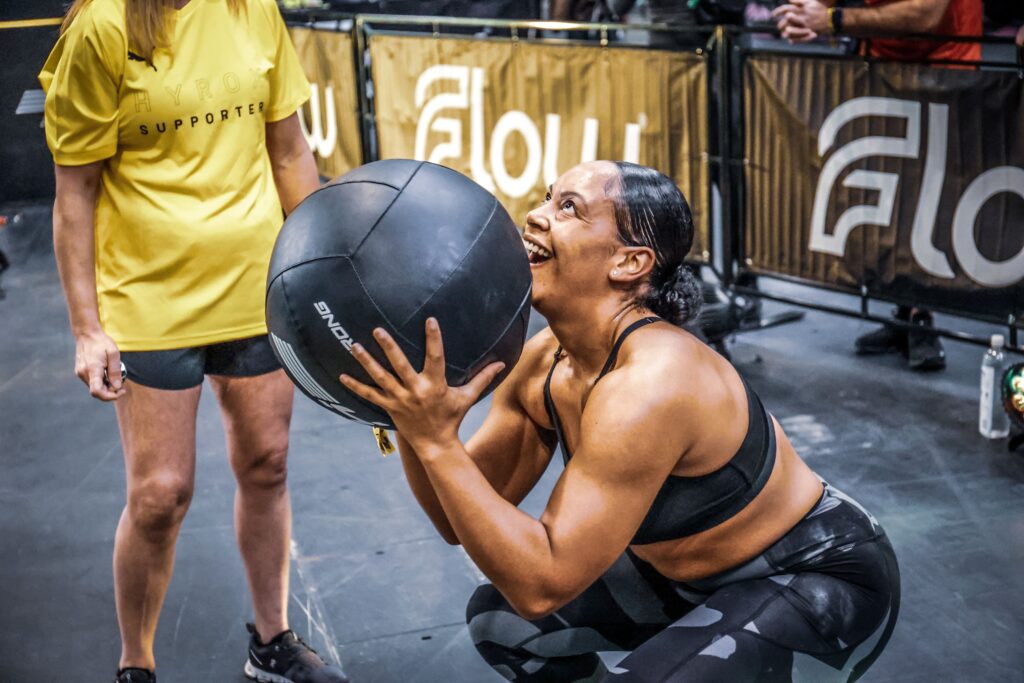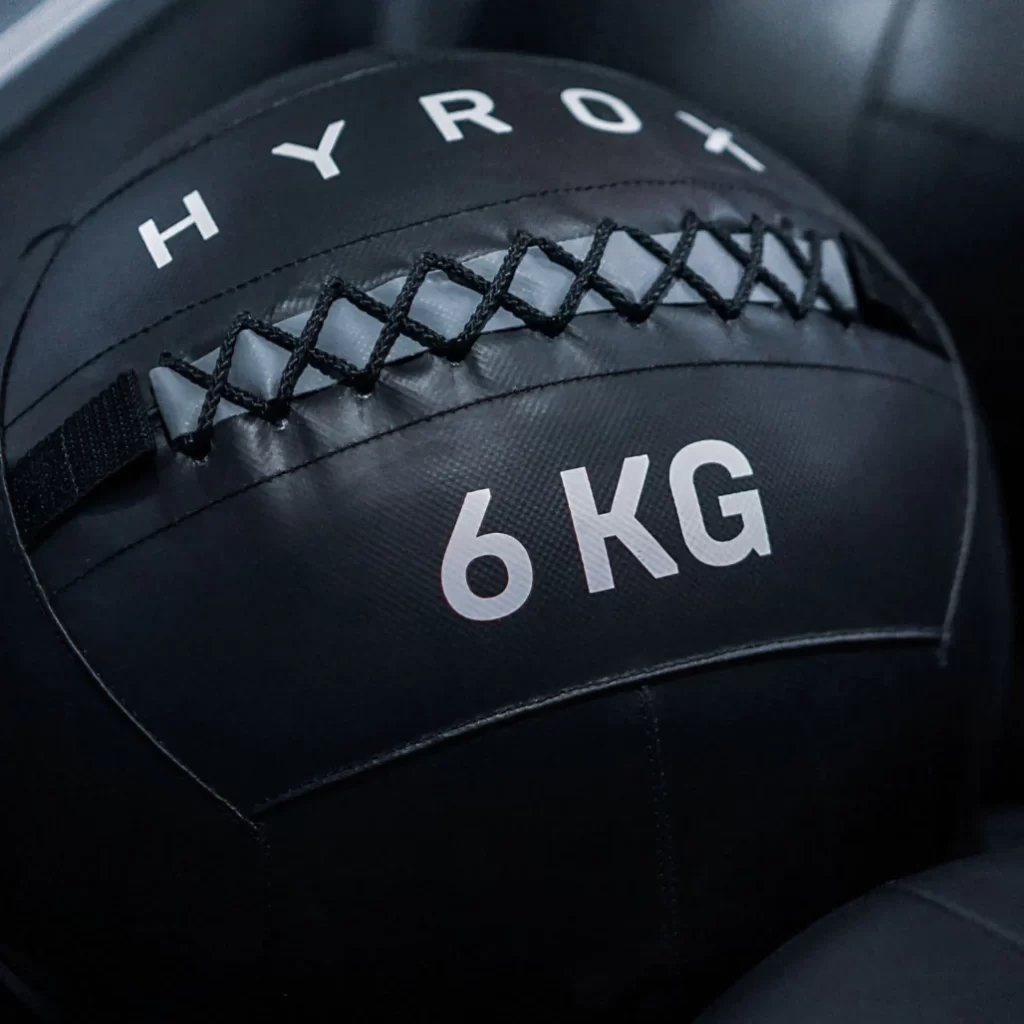Here at Honest Health Hub, over the coming week’s we will be posting a series of articles on tips and strategies to improve each HYROX station. First up, it’s….. wall balls. The hyrox wall ball height for all categories is as follows:
- Hyrox wall ball height WOMEN and WOMEN PRO 2,70 m (bottom of the two targets)
- Hyrox wall ball height MEN and MEN PRO 3,00 m (top target)
Wall balls (the final station) in HYROX are a dynamic blend of strength, endurance, and precision. This guide is your key to not only improving your time but also mastering the technique required for this challenging element. Whether you’re a seasoned athlete or a newcomer to fitness competitions, refining your wall ball skills is a game-changer in the world of HYROX.
HYROX Wall Ball Requirements

The wall ball requirements, by category, in HYROX are as follows:
Women: 75 Reps * 9lbs (4kg) ball – to 9-foot target
Women Pro: 100 Reps * 14lbs (6kg) ball – to 9-foot target
Men: 100 Reps * 14lbs (6kg) ball – to 10-foot target
Men Pro: 100 Reps * 20lbs (9kg) ball – to 10-foot target
Mixed Doubles: 100 Reps * 14lbs (6kg) ball – to 9-foot target
Women Doubles: 75 Reps * 9lbs (4kg) ball – to 9-foot target
Men Doubles: 100 Reps * 14lbs (6kg) ball – to 10-foot target
Section 1: Understanding the Wall Ball in HYROX

The Dynamics of HYROX Wall Balls: The wall ball exercise in HYROX is more than just tossing a weighted sphere to a marked target. It encapsulates a combination of power, accuracy, and efficiency. Participants must seamlessly integrate this movement into a sequence of exercises, making it a pivotal element in the overall competition.
The Weighted Challenge: The weight of the ball varies between categories, with a 6kg ball for women and a 9kg ball for men. This added resistance amplifies the challenge, requiring athletes to not only exhibit strength but also strategic control throughout the movement.
Precision at a Set Height: Beyond the weight, precision is paramount. The target, typically set at a standardized height, demands accurate throws. Athletes need to strike a balance between power and control to consistently hit the target, as missed throws incur both time penalties and energy expenditure.
Core Engagement and Full-Body Activation: Executing a successful wall ball throw is a full-body endeavor. It engages the legs, core, and upper body in a coordinated effort. The squatting motion activates the lower body, while the explosive throw recruits the muscles in the core and upper body, making it a holistic exercise that tests overall athletic prowess.
Time-Efficiency Considerations: In HYROX, where time is of the essence, efficiency in the wall ball component becomes a strategic advantage. Athletes must not only master the physical aspects of the throw but also optimize their technique to minimize transition times and conserve energy for subsequent challenges.
Adaptability to Various Environments: One unique aspect of HYROX is the diversity of environments in which it takes place. Athletes may encounter wall balls in both indoor and outdoor settings, each presenting its own set of challenges. Understanding how to adapt the wall ball technique to different terrains is crucial for success.
Continuous Integration in the HYROX Sequence: What sets HYROX apart is the continuous flow from one exercise to another. The wall ball is often integrated into a sequence of movements, requiring athletes to seamlessly transition from, for example, a run to a wall ball throw. Understanding how to conserve energy during transitions without compromising performance is a strategic skill.
Section 2: Techniques to Improve Wall Ball Efficiency in HYROX

1. Mastering the Stance and Grip:
- Stance Precision: Initiating a successful wall ball throw starts with the right stance. Begin with your feet positioned shoulder-width apart, ensuring a stable and balanced foundation. The distribution of weight across both legs is critical for generating power during the squat and subsequent throw.
- Grip Dynamics: Holding the ball at chest level, with both hands beneath its center, provides optimal control and leverage. Spread your fingers across the surface of the ball to enhance grip. This grip configuration not only aids in control during the descent but also facilitates a more efficient transfer of power during the upward throw.
2. Engage the Hips for Explosive Power:
- Hip-Initiated Movement: The squatting motion of the wall ball involves more than bending the knees. It is crucial to initiate the movement from the hips. This engages the powerful muscles in your hips and glutes, allowing you to harness maximum force for the upward throw.
- Hip Drive Dynamics: As you descend into the squat, focus on driving your hips back and down. This motion preloads your muscles, and the explosive extension of the hips during the upward phase of the squat propels the ball upward with considerable force.
3. Optimal Range of Motion:
- Full Squat Depth: Achieving a full range of motion during the squat is paramount. Ensure that your hips descend below the level of your knees. This maximizes the engagement of the lower body muscles and facilitates a more potent upward thrust during the throw.
- Efficient Squatting: Strive for efficiency in the squatting motion. A fluid and controlled descent, followed by a powerful ascent, minimizes energy expenditure and optimizes the overall efficiency of the wall ball movement.
4. Leveraging Upward Momentum:
- Explosive Upward Thrust: The upward phase of the wall ball throw is where the explosive power is crucial. Utilize the momentum generated from the squat to drive the ball upward. This should be a dynamic, controlled movement, ensuring accuracy in hitting the target.
- Controlled Follow-Through: While the focus is on generating power, a controlled follow-through is equally vital. Allow the ball to leave your hands smoothly, maintaining stability in your stance. This control ensures accuracy and sets you up for a seamless transition to the next part of the HYROX sequence.
5. Practice Variability:
- Mixing Intensity Levels: Incorporate variability in your training. Practice both high-intensity wall ball throws for speed and lower-intensity throws for precision. This variability prepares you for the dynamic nature of HYROX, where you’ll need to modulate your effort based on the demands of the competition.
- Adaptation to Different Targets: Experiment with targets set at different heights during training. This adaptability enhances your ability to quickly adjust to the specific requirements of the HYROX course, where target heights may vary.
Section 3: Targeted Training to Improve Wall Ball Performance in HYROX

1. Strength Training Essentials:
- Leg Strength: Wall balls heavily engage the muscles of the lower body, particularly the quadriceps, hamstrings, and glutes. Incorporate compound exercises like squats and lunges into your training regimen. These exercises not only build raw strength but also enhance your ability to generate power during the squat phase of the wall ball.
- Core Stability: A strong core is pivotal for maintaining balance and control during wall ball movements. Integrate exercises such as planks, Russian twists, and medicine ball slams to fortify your core muscles. This stability is essential for a controlled descent into the squat and a powerful ascent during the throw.
- Upper Body Endurance: While the lower body plays a dominant role, the muscles of the upper body also contribute significantly. Build endurance in your shoulders, arms, and back through exercises like shoulder presses, lateral raises, and rows. This endurance ensures sustained accuracy and power throughout a HYROX event.
2. Interval Training for Wall Balls:
- High-Intensity Intervals: Mimic the demands of HYROX by incorporating high-intensity interval training (HIIT) into your wall ball sessions. Alternate between periods of maximum effort wall ball throws and brief periods of rest or lower-intensity exercises. This mirrors the stop-and-start nature of the competition, enhancing your ability to recover quickly between wall ball sets.
- Mixing Wall Balls with Cardiovascular Exercises: Integrate wall ball sets with cardiovascular exercises like sprints or rowing. This combination not only builds cardiovascular endurance but also simulates the transitions between different elements in HYROX.
3. Emphasis on Technique Refinement:
- Specificity in Practice: Dedicate specific sessions to wall ball practice, focusing on refining your technique. Use varying ball weights and target heights to simulate the conditions you might encounter in HYROX. This targeted practice allows you to fine-tune your movements for both efficiency and accuracy.
- Real-Time Adjustments: During training sessions, pay attention to the subtleties of your form. Make real-time adjustments based on the feedback your body provides. This mindful approach helps ingrain proper technique, reducing the likelihood of form degradation during the intensity of a HYROX event.
4. Mental Strategies for Wall Balls:
- Visualization Techniques: Mental preparation is as crucial as physical training. Visualize successful wall ball throws, focusing on hitting the target with precision. This mental rehearsal enhances muscle memory and builds confidence in your ability to perform well during HYROX.
- Focus on Breathing: Develop a rhythmic breathing pattern during wall ball sets. Controlled breathing not only contributes to overall stamina but also helps maintain focus and composure, especially when faced with the time constraints of a competitive environment.
5. Replicate HYROX Transitions:
- Seamless Exercise Transitions: In HYROX, efficient transitions between exercises can significantly impact overall performance. Practice seamless transitions from preceding exercises to wall balls in your training. This involves not just physical movements but also mental preparedness for quick switches between different elements of the competition.
- Mock HYROX Sequences: Devote specific workouts to mimic HYROX sequences, including wall balls in combination with other exercises. This holistic approach ensures that your body is conditioned to seamlessly integrate wall balls into a dynamic and varied routine.
Section 4: Fine-Tuning Your HYROX Wall Ball Technique
1. Video Analysis for Precision:
- Recording Your Practice: Take advantage of technology by recording your wall ball practice sessions. This provides a valuable visual aid for assessing your technique. Pay attention to elements such as the depth of your squat, the trajectory of the throw, and your overall body mechanics.
- Identifying Areas of Improvement: Analyze the recorded footage to identify areas where your technique can be refined. Look for inconsistencies in your form and take note of any patterns in your movement that might affect accuracy or efficiency.
2. Coach Feedback for Personalized Guidance:
- Engage with a Coach: Seeking feedback from a coach or experienced athlete can offer personalized insights. An external perspective can identify nuances in your technique that might be challenging to notice on your own. Coaches can provide targeted advice to address specific aspects of your wall ball performance.
- Interactive Sessions: If possible, engage in interactive coaching sessions where you can receive real-time feedback. This allows for immediate adjustments, ensuring that you are actively implementing the guidance provided.
3. Consistent Practice for Muscle Memory:
- Repetition Builds Muscle Memory: Consistency is key to ingraining the optimal wall ball technique. Regularly practicing the movement allows your body to develop muscle memory. This is crucial for executing precise and efficient throws during the dynamic environment of HYROX.
- Progressive Challenges: Gradually increase the complexity of your wall ball practice. This could involve adjusting the target height, experimenting with different ball weights, or incorporating variations such as lateral throws. Progressive challenges prevent stagnation and enhance adaptability.
4. Visualization Techniques for Mental Preparation:
- Positive Visualization: Beyond the physical aspect, mental preparation is instrumental. Visualize successful wall ball throws in a HYROX setting. Picture yourself hitting the target with accuracy and seamlessly transitioning to the next element of the competition. Positive self-talk is a powerful tool in maintaining mental resilience.
- Mental Rehearsal: Practice mental rehearsal before actual wall ball sets. Imagine the entire sequence, from the squat descent to the powerful throw. This mental rehearsal conditions your mind to respond effectively during the actual execution, contributing to a smoother and more controlled performance.
5. Addressing Fatigue and Endurance:
- Endurance-Specific Wall Ball Sets: As fatigue is a factor in HYROX, incorporate sets of wall balls into your training that specifically target endurance. This involves maintaining a consistent pace over an extended duration, simulating the demands of the competition.
- Interval Training for Fatigue Management: Integrate intervals that mimic the fatigue levels you might experience during HYROX. This not only builds physical endurance but also prepares you mentally to maintain focus and precision when tired.
6. Adapting to Different Terrains:
- Outdoor and Indoor Practice: Given the varied environments in HYROX, practice wall balls in both indoor and outdoor settings. Outdoor practice introduces elements like wind and uneven surfaces, enhancing adaptability. Familiarity with different terrains ensures that you can adjust your technique accordingly during the competition.
7. Peer Collaboration for Shared Insights:
- Training with Peers: Collaborate with peers who are also preparing for HYROX or similar competitions. Peer training sessions provide an opportunity to share insights, observe different techniques, and collectively problem-solve. This collaborative approach can bring fresh perspectives to your training.
Section 5: Additional Tips for HYROX Wall Balls Success

1. Equipment Familiarity:
- Use Familiar Gear: In the world of HYROX, familiarity with your equipment is paramount. Practice wall balls with the same type of ball and target height you’ll encounter in the competition. This ensures that you’re comfortable and confident with the gear, reducing the likelihood of unexpected challenges on event day.
- Footwear Matters: Pay attention to your choice of footwear. Opt for shoes that provide stability and support during dynamic movements. The right footwear contributes to a solid base, especially during the squat phase of the wall ball.
2. Efficient Transitions between Elements:
- Practice Transitions: HYROX is not just about excelling in individual exercises; it’s about seamlessly transitioning between them. Dedicate specific training sessions to practice moving from preceding exercises to wall balls. This could involve jogging to the wall ball station or integrating a quick bodyweight movement before the throw.
- Minimize Downtime: Time efficiency is critical. Work on minimizing the downtime between exercises. Develop a rhythm that allows you to move swiftly from one element to the next, optimizing the overall flow of your HYROX performance.
3. Precision in Time Management:
- Strategic Time Allocation: HYROX demands strategic time management. During wall ball sets, allocate time judiciously. While speed is essential, rushing can lead to errors. Strike a balance between a brisk pace and ensuring each throw is accurate, avoiding penalties for missed targets.
- Strategic Rest Periods: If HYROX allows for strategic rest periods, use them wisely. Incorporate controlled breathing and mental focus during these intervals. This not only aids recovery but also prepares you for the upcoming challenges.
4. Hydration and Nutrition Strategies:
- Pre-event Nutrition: Consider your nutrition strategy before the competition. Ensure you’re well-hydrated and have consumed a balanced meal that provides sustained energy. Dehydration and inadequate nutrition can significantly impact performance, especially in a demanding event like HYROX.
- Hydration During: HYROX is physically demanding, and staying hydrated is crucial. Develop a hydration strategy that includes periodic sips of water during breaks. Keep in mind that small, frequent sips are often more effective than large quantities at once.
5. Mental Resilience Techniques:
- Positive Affirmations: Cultivate a positive mindset. Incorporate affirmations that boost confidence and focus. Remind yourself of your training, your capabilities, and the progress you’ve made. Positive self-talk is a powerful tool in maintaining mental resilience.
- Mindful Breathing: Integrate mindful breathing techniques into your practice. This not only supports physical performance but also helps manage stress and anxiety. During wall ball sets, focus on your breath to stay centered and composed.
6. Simulate Event Conditions:
- Mock HYROX Workouts: As the competition approaches, incorporate full or partial mock HYROX workouts into your training routine. This involves running through a sequence of exercises that closely mirrors the event. Simulating the conditions helps acclimate your body and mind to the challenges of HYROX.
- Event-Day Dress Rehearsals: Consider conducting dress rehearsals on event day. This involves wearing the same gear, including shoes and clothing, that you plan to use during HYROX. Familiarity with your outfit enhances comfort and eliminates potential distractions.
In essence, success in HYROX wall balls extends beyond physical prowess. It involves a holistic approach encompassing equipment familiarity, efficient transitions, precision in time management, hydration and nutrition strategies, mental resilience techniques, and realistic event simulations.
With these additional tips, you are well-equipped to conquer the wall ball element in HYROX with confidence and finesse!
Section 6: Recovery Strategies for Post-Wall Ball Efforts in HYROX

1. Cool Down and Stretching:
- Post-Exercise Stretching: Following the intense efforts of wall balls, a thorough cool-down is crucial. Incorporate dynamic stretches that target the muscles engaged in the wall ball movement, focusing on the legs, hips, and upper body. This aids in preventing muscle tightness and enhances flexibility.
- Foam Rolling: Consider using a foam roller to release tension in specific muscle groups. Roll over areas such as the quadriceps, hamstrings, and calves. Foam rolling promotes blood circulation and accelerates the recovery process.
2. Hydration and Nutrient Replenishment:
- Hydration Continuation: Maintain a commitment to hydration post-wall balls. Replenish lost fluids by sipping water consistently. Including an electrolyte beverage can aid in restoring the electrolyte balance crucial for muscle function.
- Protein-Rich Snack: Consume a snack with a balance of protein and carbohydrates shortly after your wall ball session. This could be a protein shake, a yogurt and fruit mix, or a small meal. Protein supports muscle repair and recovery.
3. Active Recovery Techniques:
- Light Cardiovascular Activity: Engage in light cardiovascular activity post-wall balls. This could include a brisk walk, light jogging, or cycling. This promotes blood flow, which aids in the removal of metabolic byproducts produced during exercise.
- Mobility Exercises: Incorporate mobility exercises to enhance joint flexibility. This is particularly beneficial for areas like the hips and shoulders, which are extensively involved in wall ball movements.
4. Rest and Sleep:
- Prioritize Quality Sleep: Adequate rest is a cornerstone of recovery. Ensure you prioritize quality sleep, especially after intense training sessions. Quality sleep is when the body undergoes repair and regeneration, which is essential for optimal performance.
- Strategic Rest Days: Designate specific days for rest or low-intensity activities. This allows your body to recover fully from the demands of wall ball workouts, reducing the risk of overtraining and injury.
5. Injury Prevention Strategies:
- Listen to Your Body: Pay attention to any signs of fatigue or discomfort during and after wall ball sessions. If you notice persistent pain or unusual sensations, consult with a healthcare professional. Addressing minor issues promptly can prevent them from escalating into more significant injuries.
- Cross-Training: Integrate cross-training activities into your routine. This diversifies the stress on your body, reducing the risk of overuse injuries associated with repetitive movements.
6. Mental Recovery Techniques:
- Mindful Reflection: Take time for mindful reflection after your wall ball efforts. Acknowledge your accomplishments and areas for improvement. This positive mindset contributes to mental recovery.
- Relaxation Practices: Incorporate relaxation techniques such as deep breathing or meditation. These practices help manage stress, promoting overall well-being and enhancing your mental readiness for subsequent workouts.
7. Periodized Training Plans:
- Periodization: Consider adopting a periodized training plan that incorporates phases of intensity and recovery. This strategic approach optimizes long-term performance and minimizes the risk of burnout.
- Consultation with a Trainer: If possible, consult with a fitness professional to develop a personalized periodized plan that aligns with your HYROX preparation goals.
In conclusion, recovery after wall ball efforts is a nuanced process that involves physical, nutritional, and mental aspects. Implementing these strategies collectively supports your body’s ability to bounce back effectively, ensuring you’re ready for the next challenge in your HYROX journey.
Congratulations on completing this comprehensive guide to mastering wall balls in HYROX! Wishing you success in your fitness endeavors.
If you would like to read more of our articles on HYROX, please click the links below:
